Plan your annual budget for project management technology.

Which comes first, the business case for project management (PM) technology or the budget?
It’s a tricky question.
Technically, you need approval for your business case before you can secure funding for the investment. However, you need to know at a high level how much your PM tech investment will cost in order to create the business case.
With head-scratchers like this, is it any wonder that funding is a key challenge small and midsize businesses (SMBs) face when planning investments in new technology?
To help you figure out how much you should budget for PM software, we asked hundreds of U.S.-based SMBs what they’re planning to spend in 2020 as part of our annual Top Technology Trends survey.
Our findings, presented below, highlight how many of your peers have budgets squared away for PM tech in 2020 and how much they’re planning to spend on these solutions.
Knowing what your peers are spending can help you make a more informed business case for PM software, better positioning you to secure funding for a 2020 investment.
How many SMBs have budget set aside for PM tech through 2021?
Key findings:
41% of SMBs have budget set aside for PM tech through 2021.
Outliers by industry: 53% of SMBs in the financial services industries have a budget set aside for PM software; only 35% of SMBs in the manufacturing industry have a budget set aside for PM software.
We first asked respondents about the technology they have budget set aside for in 2020 (not the tech they want to invest in, but the tech they’ve already secured funding for).
Following core business software such as accounting, HR, and CRM, 41% of SMBs have budget set aside for PM tech in 2020.
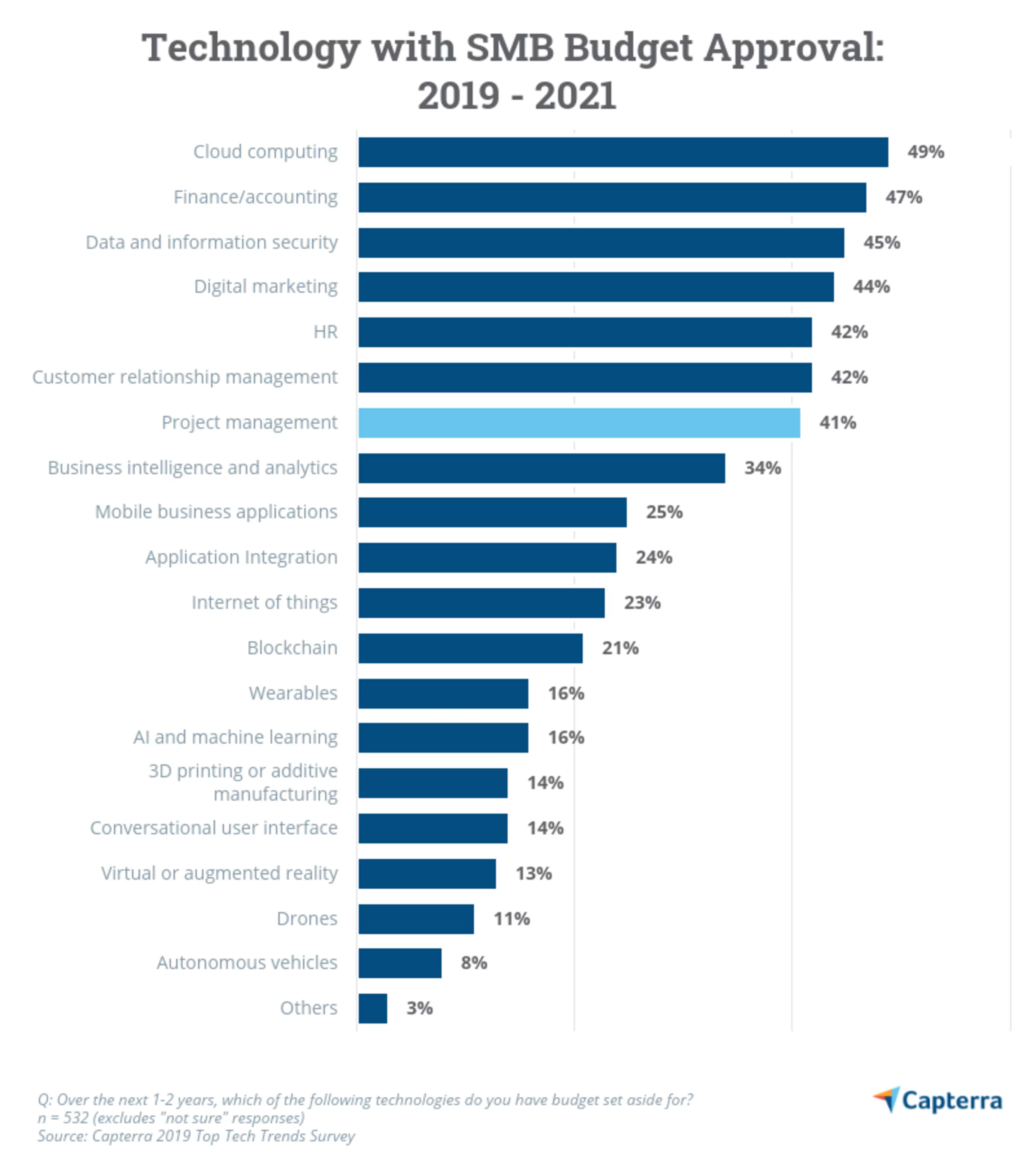
Analysis: “PM tech” is now used as an umbrella term, encompassing a range of solutions from lightweight task management tools up to robust portfolio management solutions. While bucketed together, these tools vary drastically based on the target end user and key functionality.
For example, task management software helps individuals stay on top of to-dos, while portfolio management software helps project managers and organizations plan, evaluate, and execute multiple project initiatives within a portfolio.
Regardless of whether you’re managing tasks or a portfolio of projects, PM tech offers numerous benefits, such as increasing transparency, streamlining processes, and improving productivity and team effectiveness. Additionally, these tools provide a wealth of performance data that leaders can use to make more informed project and business decisions.
Therefore it comes as no surprise that more and more SMBs are embracing PM tech as a core business system. In fact, 96% of SMB leaders surveyed as part of our 2019 Top Tech Trends survey say PM software is critical or beneficial to their business.
It’s clear that PM tech is important to SMBs as a whole, but is it more or less important when you consider business size and business segment?
To find out, we broke down the total sample of SMBs with budget set aside for PM tech by annual revenue as well as industry to highlight statistically relevant comparisons.
Outliers by size of business (annual revenue): When we break the data down by size of business, we see that an above-average number of small businesses (those with $10 to $50 million in annual revenue) have budget set aside for PM tech through 2021 when compared to the sample of SMBs as a whole—46% compared to 41%.
For context, we ran our survey in July 2019. These organizations set aside budget for investments in 2020 and 2021 several months in advance, which indicates that PM tech is a vital part of these organizations’ growth strategy for the next few years.
Meanwhile, fewer midsize businesses (those with $50 to $100 million in annual revenue) have budget set aside for PM tech through 2021 when compared to the sample of SMBs as a whole—33% compared to 41%.
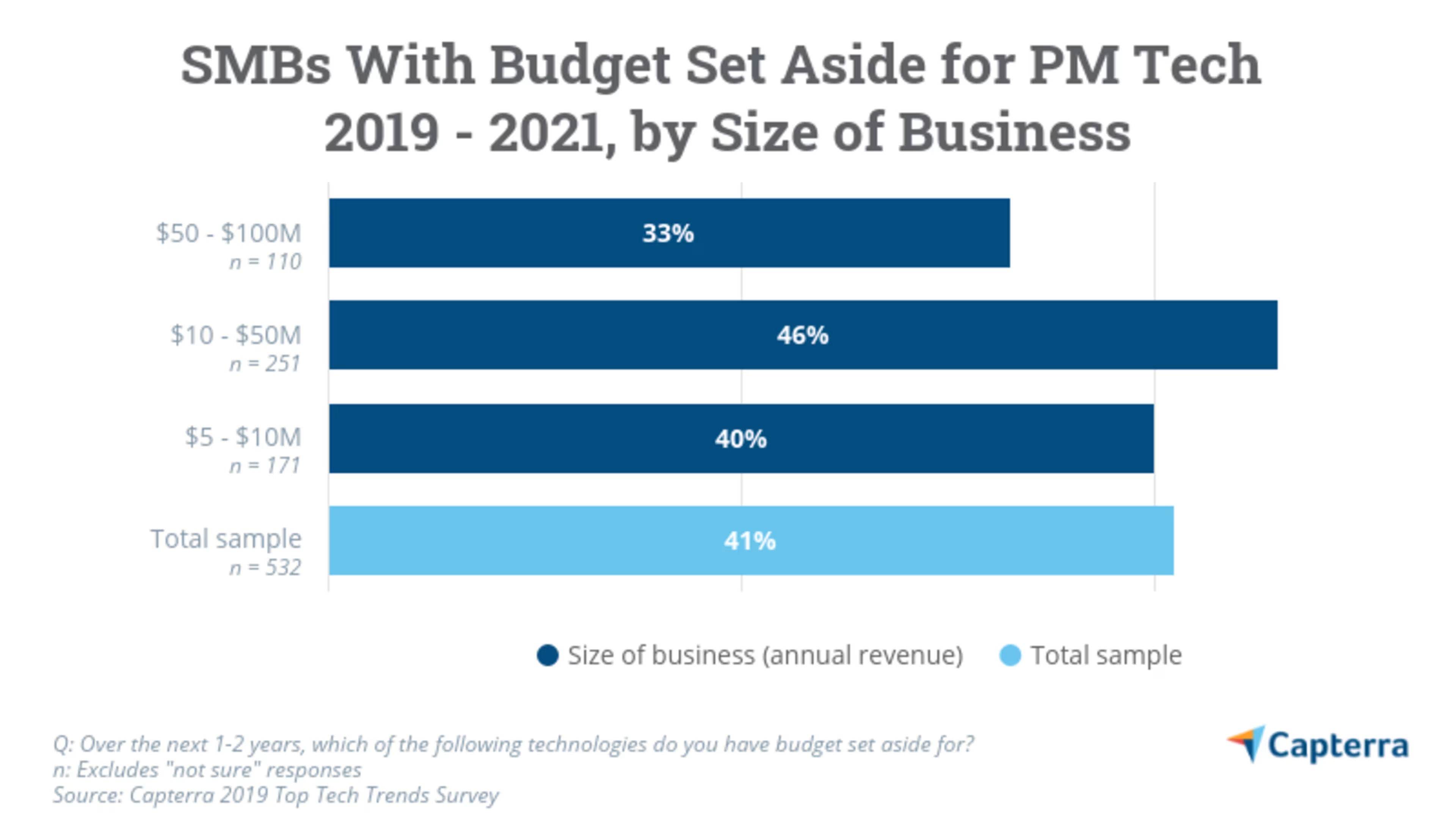
It’s unlikely that midsize organizations simply won’t invest in PM tech through 2021, and more likely that business leaders haven’t yet figured out how much they want to spend relative to their other technology investments.
This is likely indicative of business leaders’ wariness regarding an impending recession, causing them to carefully weigh investment considerations before deciding which technology to budget for.
For example, PMI reports that almost 10% of every dollar is wasted as a result of poor project performance. Therefore, if SMBs can leverage PM tech to improve project performance, they can re-invest those savings into other areas of the business.
Note: If you’re in the process of creating your business case for PM technology (meaning, you haven’t yet secured funding), don’t skirt the recession issue. Address it head-on in your presentation and highlight the numerous ways that PM technology can benefit your business, especially during a recession.
Outliers by industry: When we break the data down by industry, there are a few that stand out from the aggregate sample. An above-average number of SMBs in financial services have budget set aside for PM tech, compared to the sample of SMBs as a whole. On the other end, a below-average number of SMBs in manufacturing have budget set aside for PM tech, compared to the sample of SMBs as a whole.
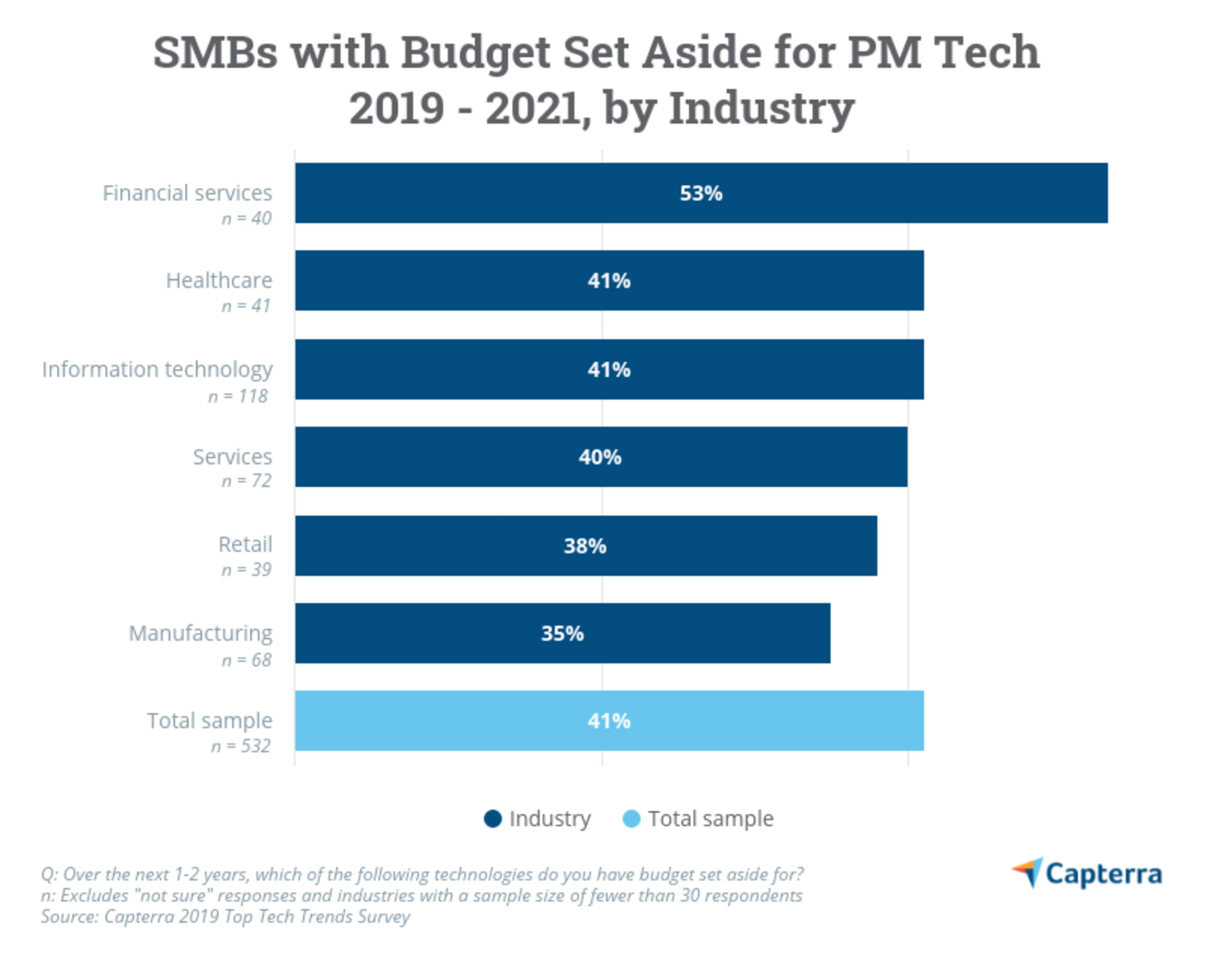
While some industries have been quick to set aside funding for PM technology investments through 2021, others appear more cautious.
This can be attributed in part to differences in the number and/or complexity of projects across different industries—those where there’s a greater risk associated with project failure are more likely to consider PM tech critical to their business and set aside funding earlier.
It’s also representative of business leaders preparing for a recession by approaching technology investments with more careful consideration.
The manufacturing industry is especially volatile right now due to tariffs and trade wars. While the U.S. economy is plateauing, the manufacturing industry is contracting (September marked the worst month for U.S. manufacturing since 2009).
While it makes sense that organizations in manufacturing and related industries are approaching spending with more caution, PM is not an area many can afford to make cuts in.
As Mark Langley—president and CEO of Project Management Institute—states in the 2018 Pulse of the Profession report: “If your organization is not good at project management, you’re putting too much at risk in terms of ultimately delivering on strategy.”
How much are SMBs planning to spend on PM tech in 2020?
Key findings:
46% of SMBs are planning to spend between $1,000 to $10,000 annually; 31% are planning to spend between $11,000 to $50,000 annually.
Outliers by size of business: Midsize organizations (those with $50 to $100 million in annual revenue) stand out from the total sample on both ends of the spectrum: 17% are planning to spend less than $1,000 annually (compared to 8% of the aggregate sample); 31% are planning to spend $51,000 to $100,000 annually (compared to just 12% of the aggregate sample).
Outliers by industry*: 57% of SMBs in the financial industry are planning to spend $1,000 to $10,000 annually on PM software (compared to 46% of aggregate sample); 38% of SMBs in the services industry are planning to spend $11,000 to $50,000 annually on PM software (compared to 31% of aggregate sample).
*Because of small sample sizes, the outliers by industry are more directional and less statistically representative.
We next asked the SMBs with budget set aside for PM tech how much they’re planning to spend in 2020.
Nearly half of SMBs with budget set aside for PM tech in 2020 are planning to spend between $1,000 to $10,000 annually, while just under one third are planning to spend between $11,000 to $50,000 annually.

Analysis: As we said above, PM tech encompasses a range of solutions that vary based on end user and functionality. Each of these variances affects the cost of the software.
For example, cloud-based PM software is commonly sold by user license, so the cost of the software varies based on the number of users on the system.
Additionally, cloud-based tools are typically sold in product tiers, with different features available at different price points. So again, the cost of the software varies based on the type of functionality required.
Because of this range, we can infer that businesses with their budget squared away for PM tech in 2020 already know who their end users are, how many end users they’re looking to purchase software for, and which software features they need to support end users’ processes.
If you haven’t yet performed this type of stakeholder analysis, that will be a critical part of putting together your business case.
For quick reference, here is an example of how the cost of PM software will vary based on the type of user license you’re purchasing and the number of users you’re purchasing licenses for:
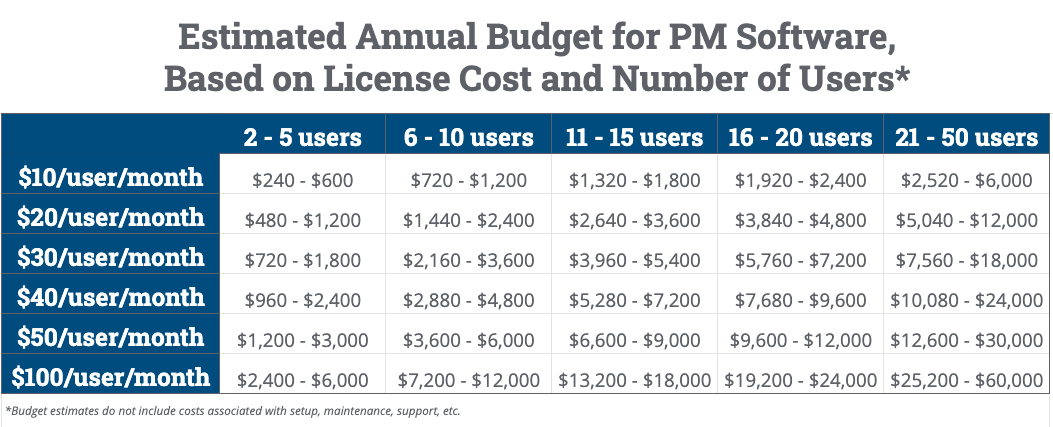
Now that we know what SMBs are spending on PM tech in general, we’ll look at budgets by size of business and industry to highlight statistically relevant comparisons.
Outliers by size of business (annual revenue): When we break the data down by size of business, there’s one major outlier that stands out from the aggregate sample for how much they’re planning to spend on PM tech in 2020.
Midsize organizations (those with $50 to $100 million in annual revenue) are split, with statistically relevant differences on both ends of the spectrum:
17% are planning to spend less than $1,000 annually (compared to 8% of the aggregate sample).
31% are planning to spend $51,000 to $100,000 annually (compared to just 12% of the aggregate sample).

While it makes sense that larger organizations would budget more than smaller organizations for PM tech, it’s interesting that such a significant percentage are spending modestly on PM tech in 2020.
This is in stark contrast to the results of our 2018 Tech Trends survey where just 8% of midsize businesses budgeted less than $1,000 annually, and the greatest percentage planned to spend $11,000 to $50,000 annually.
Outliers by industry: When we break the data down by industry, there are two that stand out from the aggregate sample for how much they’re planning to spend on PM tech in 2020:
Financial services: An above-average number of SMBs in financial services are planning to spend between $1,000 to $10,000 annually on PM tech in 2020, compared to the sample of SMBs as a whole (57% compared to 46% of the total sample).
Manufacturing: SMBs in manufacturing are planning to spend more than $10,000 annually for PM tech in 2020, compared to 46% of the total sample).
However, it’s important to note the small sample size for both outliers (21 respondents in financial services and 23 respondents in manufacturing). Because of small sample sizes, the data in the chart below is more directional and less statistically representative.
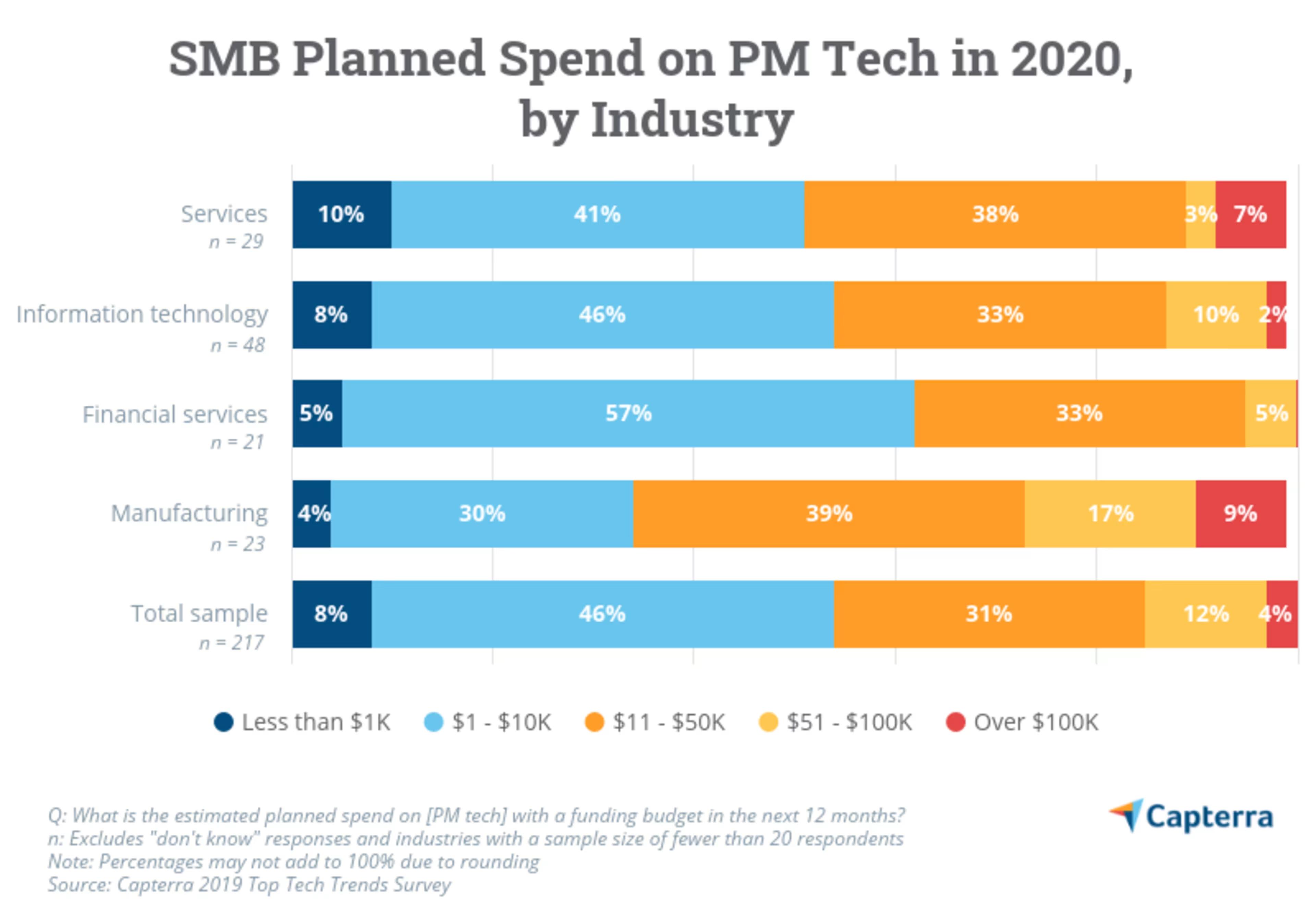
How to plan your budget for PM tech in 2020
Did you catch all that? We just shared a lot of data, so let’s talk for a moment about how you can leverage it.
Use the “total sample” statistics cited above as your starting point.
Consider whether your size of business or industry is an outlier (either above or below average compared to the sample as a whole). If you’re in an above-average bucket, use that data to support your business case. For example, if your organization makes between $5 to $10 million in annual revenue, you can leverage the fact that an above-average number of your peers are spending $1,000 to $10,000 annually to show that a proposed budget of that amount is realistic and will keep you competitive with your peers.. If you’re in a below-average bucket, address those findings head-on in your presentation. For example, if you’re in the manufacturing industry, be prepared to answer questions and concerns around proposed spending in the face of an impending recession and show decision-makers how an investment in PM tech can actually help your organization be more efficient with fewer resources.
Follow these six steps and download our business case template to ensure you’re including all the info you need to secure funding for an investment in PM tech.
Of course, once your business case is approved, the project is just getting started. For tips on everything from improving processes to implementing technology, follow our project management blog.
Information on Capterra’s 2019 Top Technology Trends for SMBs survey
All percentages are rounded to the nearest whole number.
Information on Capterra’s 2018 Top Technology Trends for SMBs survey
All percentages are rounded to the nearest whole number.